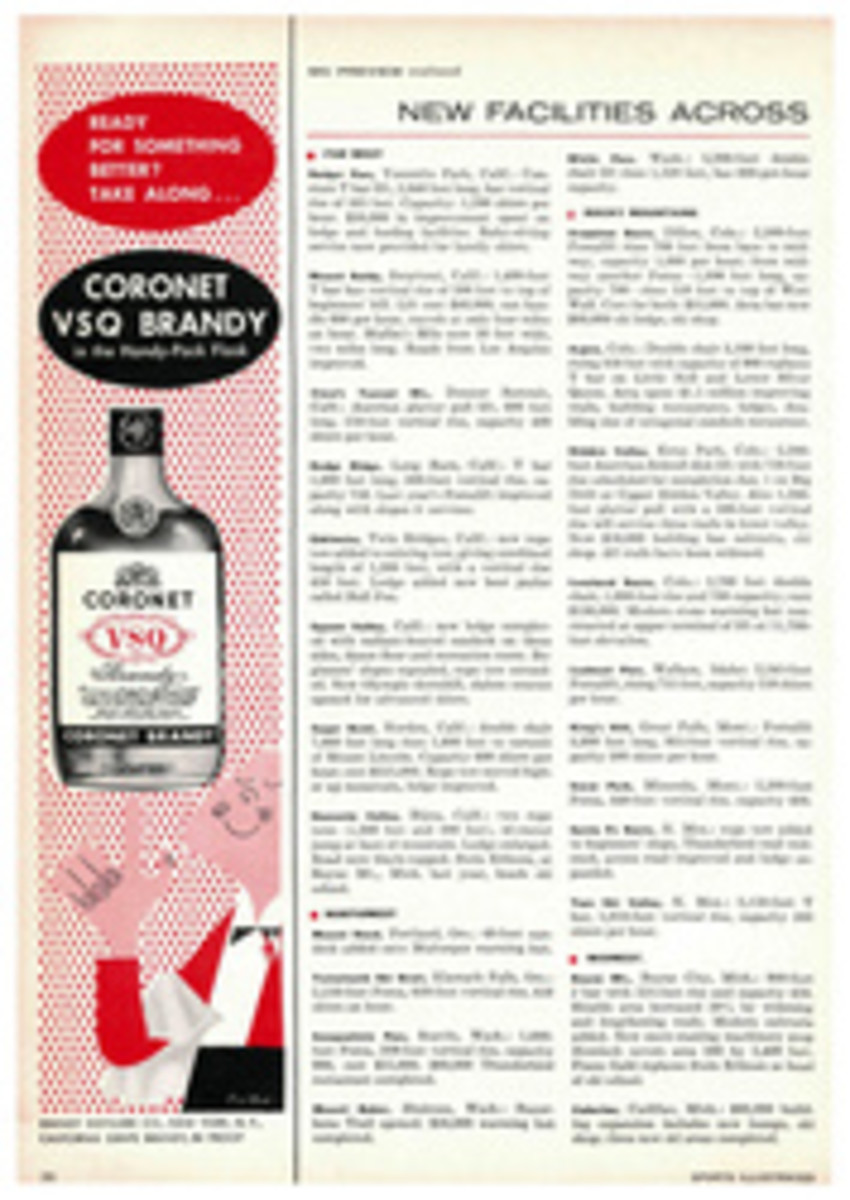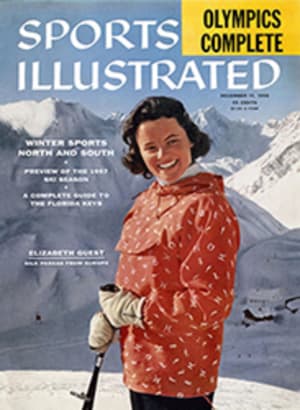
FOOTLOOSE SPORTSMAN
Driving down the string of Keys, that artificial tail that Florida waves in the face of tropical latitudes, is something like driving along a pier that stretches for 112 miles into the sea. At the far end is Key West, a four-mile-by-two-mile preserve that lives on Navy, tourists and fish. Along the route are shellfish called conchs; people called Conchs; endless kitchens producing turtle steaks, conch chowders and Key lime pie; and some 700 mangrove islands called Keys. The Keys are variously known as Fat Deer Key, Knockemdown Key, No Name Key and Pigeon Key, itself the smallest inhabited island in the world. Greyhound buses stop on Greyhound Key, a tiny pied à terre built for rest stops between Key West and Miami, 157 miles apart.
There being such a shortage of land, billboards and telegraph poles are set up in the water, and when the road runs out of all visible real estate, it rolls inexorably on, quite undaunted—a viaduct across the trackless blue. Then as you drive your car southward to sea, over bridges that sometimes stretch for seven miles, the Gulf of Mexico is on the starboard, the Atlantic on the port. Cormorants and gulls sit on the fat pipe that sends water south, lolling in the sun like drugstore cowboys on a lazy Kansas afternoon. And the Atlantic lies still as an ice pond, with only the reflection of the sun-brightened clouds to alter the even patina of blue.
The Upper Keys have a monopoly of the best restaurants along the strip. The Olney Inn, in a grove of palms by the ocean at Islamorada, is a branch of that antique-filled Maryland nest so well known to Washingtonians. The Fern Inn at Islamorada is run by Fern Butters, who started the place 30 years ago and is credited with inventing Key lime pie, a dish which she has dispatched to President Eisenhower, Arthur Godfrey and other statesmen.
A few minutes to the south, on pilings sunk into the gulf, is Blueberry Hill Key, a restaurant domain of two white houses surrounded by a picket fence, connected to U.S. 1 by a small runway, and equipped with a red life preserver, presumably for diners who come a cropper returning to their cars. Dinner is by reservation only, your request being carried on telephone wires strung over the water.
Of the motels in the vicinity, Holiday House, a smallish place with nine units, all air-conditioned, makes a specialty of taking in fishermen. Fiberglass boats are rented (guests only) at $10 and $15 a day, and there is an enclosure for swimming. The rate comes to $85 a week for two, and some units have kitchen facilities. There is no restaurant at Holiday House, but the Beachcomber next door flies in steaks from Chicago, charging about $5 for dinner. In its own gustatory interests, Holiday House keeps a line of stone-crab traps which are tended by guests. All catches are promptly impounded until there is enough for a community stone-crab party.
Also at Islamorada, which has knighted itself the Bonefish Capital of the World, is The Islander, a 48-unit motel spread over 12 oceanside acres. All are air-conditioned, equipped with tub, shower and tiled bath, and half have kitchenettes. There is a swimming pool, restaurant, outdoor barbecue and a dock on the ocean. Hotel room rates are $10 a night until Jan. 20, $13 to $16 through March 31.
Marathon, the fishing center of the Central Keys, lies at a latitude 375 miles south of Cairo, Egypt, and no frost within its corporate limits is ever more widespread than could be contained in a frozen daiquiri. Both sides of the highway are lined with bait and tackle shops. Sample name: Ye Ole Feshin' Hole. Open counter-and-stool beaneries serve breakfast to the motel patrons under signs that say "Every Day Is Fish Day," "Old Fishermen Never Die, They Just Smell That Way," and other wheezes.
Hanley's puts up Snapper Delmonico Sauté, with apples, raisins and white wine; or a shore dinner of shrimp, conch chowder, broiled filet of red snapper, fried shrimp, a broiled half lobster, green turtle sautéed and Key lime pie, all for $4. A house specialty is stone crabs, iced, and served with drawn butter and mustard sauce.
The Buccaneer Lodge is about as nice a place as I could think of to salt one's self away for the winter. With some 60 units, it nestles along the gulf, has a salt-water pool, fishing dock, aquarium, tennis courts, restaurant and bar; charges $8 to $18 a day for two, depending on the season, plus $2 if you want to be on the water. Efficiencies run from $2 to $4 more. Skippers will pick up fishermen at the dock, and the going rate is $45 a day for bone-fishing, $75 for charter boats.
One of the biggest resorts is the Jack Tar Hotel in the Keys, operated by a chain that has a similar operation in Galveston and hotels in Asheville, Clearwater and Charleston. It has a dining room, bar and coffee shop, a playground for children, a cabana colony and a double-decked swimming pool tended by Katherine Rawls. Like all the resorts in Marathon, it makes a specialty of fish, keeps a piscatorial counselor on hand in the tackle shop, and sports an ocean-front pier.
Key West, that crowded little Cuban-flavored nest just 90 miles from Batista's outposts, is surrounded by a U.S. Naval Station, a Naval seaplane base and the airfield where National Airlines lands its planes incoming from Miami. Jammed on the rest of the island, which contains the southernmost city in the U.S., are the home of Tennessee Williams; the former home of Ernest Hemingway; the onetime hideaway of Harry Truman; the onetime hideaway of Dwight Eisenhower; 26,433 citizens, one-third of whom speak Spanish; the southernmost house in the U.S., and across the street from it, the Southernmost Motel, one of 40 in town. Besides the Southernmost Motel, which has the southernmost pool, there is the Blue Marlin Motel, a double-decker affair which sports the second southernmost pool. Out near the airport is the Key Wester, which has 92 units, charges $17 to $26 for a room in winter, plus a dollar a day extra if you want to lounge on a chaise by the side of the pool. You can sit upright in a chair for nothing.
Tourists also like to see the two Little White Houses where Truman and Eisenhower stayed. Both Presidents lived on the Naval Station grounds, Truman in the small white-shuttered home of an admiral, Eisenhower in the cottage of a captain. Tours that trundle past both houses and visit the ships and submarines of the naval base depart at 10 a.m. daily except Sundays from the Chamber of Commerce Building. In memory of the visits of Truman and Eisenhower there is an avenue named for each. They cross.
Restaurants in Key West are by and large undistinguished, but I wouldn't miss places like El Anon, a Cuban icecream parlor where the flavors, so help me Howard Johnson, are cantaloupe, guava, soursop and tutti-frutti. Benny's cafeteria, Benny Fernandez, prop., offers steam tables steaming with arroz con polio, paella, pork Spanish style with black beans and pata Andalusia, which is to say, pig's feet. There is an outdoor garden, with red, white and blue chairs. Ramonin's on Duval St. is too formica-and-fluorescent to be quaint, but the menu, arranged to suit both Cubano and Conch, includes fried turtle steak, fried conch steak, broiled yellowtail, shrimp enchiladas and Spanish bean soup. There are guava shells or paste with cream cheese for dessert, and anybody fattening up for the swim to Havana can order the Cuban sandwich. It includes ham, cheese, mustard, pickle, roast beef, salami, mayonnaise and lettuce and tomato. While this frightful amalgam tastes pretty good, the danger of lockjaw should be considered.
PHOTO
MRS. R. G. RAITT of Penn Yan, N.Y. took 114-pound tarpon on a light spinning rig, guided by Dick Williams of Islamorada.

